They are among the cutest, most inquisitive, and incredibly talented babies on the planet. I’ve observed and interacted with hundreds of them, and yet...I never tire of them. They never fail to surprise and delight me. Humpback whale calves are simply incredible.
As of today, my tally of humpback calves for this season stands at 38. For context...that’s only 10 shy of my record-breaking total of 48 ID-ed calves in 2011.
Wow!
In my summary blog post for the 2011 season, I “forecast” (i.e., took a wild guess) and wrote that the number of babies this year might revert to the mean, and as a result, my calf count for 2012 might end up somewhere in the 20s. Well...so much for that bright idea.
It was pretty obvious relatively early on that we were on track for a very healthy number of babies. In previous blog posts this season, I mentioned that we were on track to meet or exceed the 2009 count (31 mother/ calf pairs), and that’s exactly what’s happened.
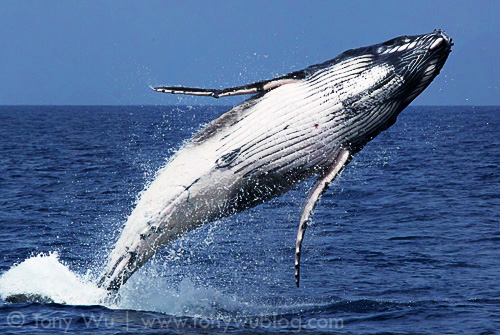
Breaching humpback whale calf (#38 of 2012 season, male)
Let that sink in for a moment.
The season isn’t over yet, and my calf count stands at 38 humpback whale calves. In light of the fact that just a few years ago, the common wisdom was that only a handful, perhaps six to eight, calves passed through Vava’u each season, this is absolutely amazing. (It also underscores the potential pitfalls of listening to common wisdom.)
The fact that the number of newborn humpback whales has remained high after a gangbuster year in 2011 is obviously a positive sign for the Megaptera population, one that we should all be thrilled about. Three cheers for a healthy humpback population!
Of course, I need to go through many thousands of photos with a fine-toothed comb after the season ends in order to reconfirm the IDs, but there is no doubt that the final tally will be significant.
It’s been about three weeks since I’ve posted a full summary, so I won’t attempt to discuss all the babies we’ve met in the interim, but here are a couple of noteworthy encounters:
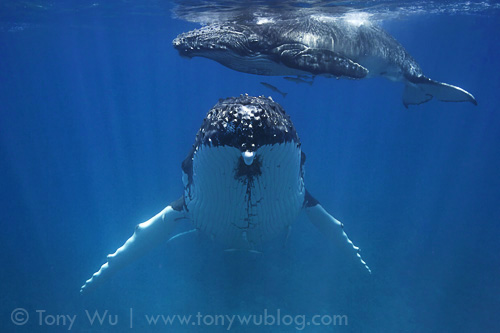
Male humpback whale calf with mommy, #26 of the season
The first is calf #26, a male juvenile that was quite the mama’s boy. The mother/ calf pair were extraordinarily friendly and tolerant of our presence, but the calf stuck close to mommy all the time, never straying much beyond the adult’s pectoral perimeter.
And the photo below is of calf #30, a baby that was in the midst of an action-packed heat run that comprised the mother/ calf pair, a lead escort, and five additional hormone-fueled challengers. This also happened to be the first proper heat run I experienced this season, so it was doubly memorable.
As you may be able to discern from the photo, a heat run is not always the most relaxing of situations for mommy and baby:

Humpback whale calf #30 with mom in a heat run, escort trailing behind
Weather, Winds, Water, Windbags
The overall conditions this season have been good. The weather has been generally benign, ocean conditions mild, and winds mostly conducive to heading out to sea. There have, of course, been some challenging days, but so far, we haven’t lost much time to inclement conditions. (Murphy’s Law: The morning after I wrote this sentence, we were hit by prolonged rain.)
If I had to characterise, I’d say it’s been an unusually dry and warm season...as evidenced by signs such as the very early ripening of kapok tree seed pods, and many-a-mango-tree positively bursting with fruit.
Also of note...the water visibility has been excellent, which is entirely unlike the situation in 2011. Visibility has been positively outstanding in many areas (I could see the bottom in the channel in front of Swallow’s Cave a couple of days ago for instance!), and even in the south, where the water is almost always stirred up and murky, visibility has been better than average.
Of particular interest, there is relatively little stuff in the water of biological origin (i.e., pink fuzzy things), which fortunately equates to less backscatter and other bits to clean up when going through photos...always a welcome relief.
I’m not sure why this is the case, but I suspect there may be some correlation to the el Nino/ la Nina weather cycles...more on this subject when I wrap up with a final blog post at the end of the season.
In tandem with the generally favourable conditions, the whales have also been reasonably friendly. As I’ve mentioned many times in the past, there seems to be an overall “mood” to every season, with whales in the area exhibiting a communal disposition that can span the entire range from proactive and engaging to downright rude. This season’s mood seems to fall somewhere in the neighborhood of “mostly affable, with scattered frumpiness”, if that makes sense.
As far as whale numbers are concerned...there have been a few periods when the whales seemed to go “poof” and vanish into the aether, though they’ve always returned. Of interest...when this happened in mid-September, we checked with a friend in Ha’apai, and learned that the situation was similar there at the time as well.
No one knows what’s behind these periodic disappearances and reappearances of whales in the area, but if you consider this topic for a moment...it totally makes sense.
Humpbacks are social animals, and they gather here for social purposes. So it should come as no surprise that their movements are coordinated to some extent. If the whales didn’t have some sort of shared (and communicated) agenda, why would they even bother to congregate?
Periods when the whales seem to be scarce obviously suck for people who are here at the time hoping to see them, but there’s a word of caution I’d like to throw out in this context...drawing conclusions from just a few days is a bad thing to do.
Periods of scarcity, as well as periods of abundance, occur each season. So basically, without a long-term view (over each season and over multiple seasons), any conclusion one makes about the presence or absence of whales is at significant risk of being invalid. There is ample potential for statements made based on limited observation to be inconsistent with fact (i.e., to be total BS).
Here’s the kicker...even if you’ve been here over multiple seasons...you have to be paying attention in order even to have a hope of teasing out possible patterns, trends or other meaningful observations. Paying attention requires a lot of effort and work, which can be tedious, labor-intensive and even painful at times.
And here’s the kicker on top of the kicker...even if you are paying attention, it’s very, very easy to be misled by events and to make mistakes. I should know...I make them all the time!
Forgive my little rant, but I’ve only just learned a couple of days ago about an alleged expert going around the world telling people blatant lies about the situation here, based on her “expertise”, i.e., a few days on the water (but no time at all in the water). It’s impossible to stop people from “flapping their traps” (as my 10th grade history teacher used to admonish us students against), but permit me to underscore the importance of applying critical thought to broad, sweeping generalisations put forth by erstwhile experts who’ve spent very little time in the places and with the subjects about which they expound.
I’ve heard such people in the past (and the present) make sweeping (usually alarmist) generalisations about things like whales running away because of boats, about a seeming scarcity of whales being indicative of unhealthy whale populations, about personally “never having seen such few whales”, etc.
I cannot fathom what drives such people to stupidity, but if you come across anyone fitting this description, please take such silly talk with an appropriately humongous grain of salt and with your BS meter on full alert.
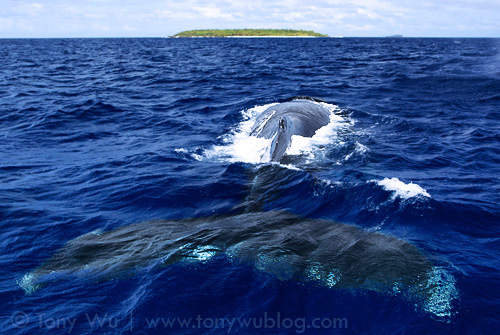
Humpback whale cruising along the ocean surface
Social Cetaceans
Heat runs are my favourite humpback whale activity to watch. I’ve seen several over the past few weeks, the most action-packed of which was on 17 September (see previous blog post).
In short, they involve a bunch of boisterous boy baleens competing for the attention of a female whale. There’s always a frenzy of activity, and the specific dynamics among the participants are always unique and fascinating.
There’s usually a male or two that seem to be dominant, while the others appear to be trying their luck. There’s a lot of pushing, shoving, grunting and groaning that takes place, and occasionally there’s blood that’s shed, though none of the cuts and bruises ever seem serious.
Sometimes the action revolves around a single female, and at other times, the activity centres upon a female that has a calf. Some females seem to enjoy the attention, while others...well, would probably prefer the boys amuse themselves elsewhere. Some females with calves even appear oblivious...I’ve seen mommies serenely feeding their babies while a manic Megaptera maelstrom rages around them!
But in any case...testosterone + hundreds of tonnes of humpback always = Woohoo! (or should that be Wuhoo?)
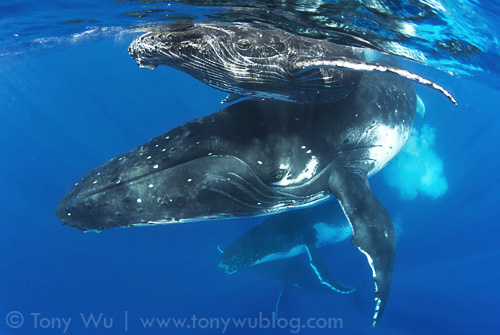
Female humpback whale and calf #33 in the midst of a heat run
Among my recent experiences though...one social interaction, which we witnessed on 28 September, stands out. It wasn’t a heat run.
This encounter involved three individuals, whales that were moving along at a steady pace...not too fast, not too slow...diving down, coming up, rubbing against one another, executing exquisite, almost balletic movements in the process.
At first glance, their actions and body language reeked of a competitive situation, one in which perhaps two males were vying for the attention of a female.
During this encounter, I saw something I haven’t witnessed before...a whale stroking its head/ rostrum area gently against the underside of another whale. This happened on at least three different occasions, though I was only able to photograph it once:
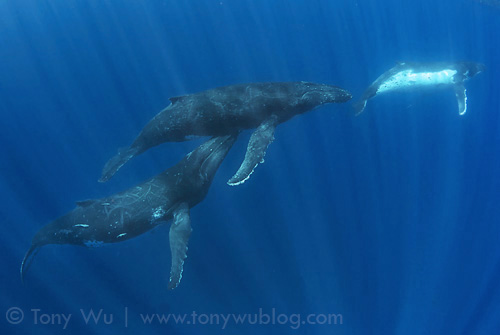
Male humpback whale nuzzling underside of another male.
Third male in the background.
In this particular instance, I saw the strokee emit a small cloud of dark liquid, right into the “face” of the stroker.
I’ve seen and photographed humpback whales pooping here before. The emission kinda looked like liquid-y poop, but there wasn’t a lot of it, and the situation sort of suggested that...well...perhaps defecation wouldn’t be the most appropriate or socially acceptable response. But who knows? There are, as I understand, humans who are in to that sort of thing (yuck).
In any case, it happened too quickly and too far away for me to get a photo of the small puff of liquid. There is, however, no doubt about what I saw.
But wait. It gets even more interesting.
Had it not been for a similar encounter I experienced two seasons ago, I may have just assumed that this situation was two males trying to impress a female, and let it go at that. I may have even interpreted the intimate interaction as a prelude to courtship and mating.
Back in 2010 though, I spent quite a bit of time swimming among three whales engaged in just about the same type of behaviour while exhibiting the same type of intimate interaction.
In that case...it turned out that all three whales were male. I dubbed them the Three Amigos.
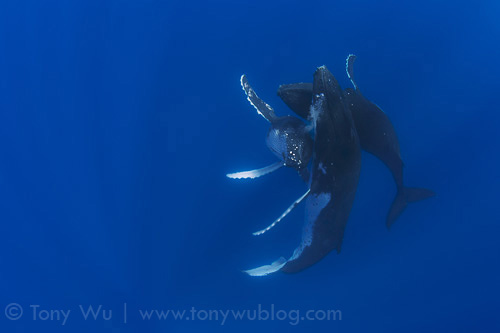
The Three Amigos...three male humpback whales
With that lead-in, I suppose it won’t come as any surprise that the three whales I encountered a few days ago also turned out to be three boys...another trio of males associating in an exceptionally intimate and seemingly affectionate manner.
For continuity with the Three Amigos, I’ve dubbed this recent triplet the Three Musketeers. (If I come across this type of situation again, the next trio will be the Three Stooges!)
You might wonder how I knew that they were boys and not girls. Well at first I didn’t...but I swam and I swam and I swam until I was able to get photos of the undersides of every whale. This allowed me to confirm their sex beyond a shadow of a doubt.
The lesson here is that you can’t assume anything. Even if whales are engaging in what appears to be intimate behaviour, you must have photographic proof of their sex. Otherwise, you can’t be certain of what’s taking place.
Now...the Three Amigos and Three Musketeers obviously beg the question of what exactly was going on in those two instances. Why would three male humpbacks invest time and energy engaging in such behaviour?
I have no answer, and I’m not prepared to speculate at this stage, but it’s certainly intriguing, and something that I’ll keep an eye out for in the future.
The one thing I’m quite certain of, however, is that the dynamics of humpback whale society are much more complicated and nuanced than we know.
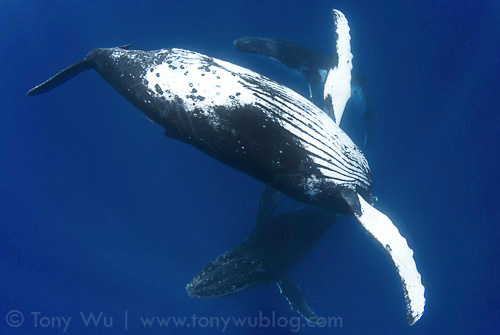
Three male humpback whales socialising...the Three Musketeers
More Megaptera Mystery
Speaking of cetacean conundrums...on 29 September, I came across what might have been a whale with a leak.
Yes...I know...that sounds preposterous, but let me explain.
Early in the morning, we came across a mother/ calf pair between Eueiki and Fua’amotu.
The visibility wasn’t great; the water was dark; the sea bottom was dark; the mom was deep; and she was mostly dark on top...so it would have been challenging (to say the least) to find the whales in the water...if not for the fact that the mom emitted a steady stream of bubbles, which allowed me to locate her with relative ease.
Humpback whales blow bubbles, so that’s nothing new. But this didn’t appear to be a conscious expelling of air. It was more akin to a leak.
At first, because the visibility wasn’t good, I thought the bubbles were coming from the sea bottom, sort of like what you see in areas with volcanic activity (PNG, Indonesia, Dominica, etc.), where gases escape from the ground and bubble into the sea. This worried me, because Tonga is adjacent to a trench, and there is certainly tectonic activity here. My gut reaction was...”Oh no! Do we have impending volcanic activity?!” I’m sure you can see why that might be a concern.
As I stared into the deep, dark, featureless water, I eventually saw a flash of white...the belly of the calf as it appeared from beneath its countershaded mother. It was only then that I realised that the bubble stream was coming from the adult whale, not from the sea floor.
I’ve never come across this before.
We did several drops with this mother/ calf pair (calf #38, a boy), so I eventually got a good look at the “leak” and was able to document it.
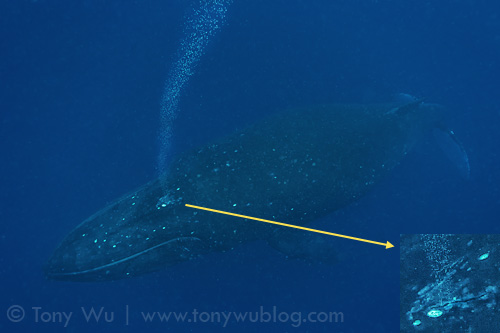
Mother of calf #38, streaming air bubbles from her blowhole
I don’t know if the bubble stream was actually coming from a leak per se, but I can’t think of any logical reason why a whale would intentionally let perfectly good air escape in a steady, non-stop stream. She did this on every dive (5-6 drops) except the final time we got into the water with her.
The fact that she didn’t emit any bubbles on the last drop suggests that she may have had conscious control over whatever was causing the bubble stream, but then again...if that were the case, why emit the bubbles at all? Hmmmmm.
The only plausible/ possible explanation I’ve been able to come up with so far is that perhaps she was sleeping/ resting during the initial drops, and while she was in that state, she may have involuntarily relaxed motor control over the muscles that hold her blowholes shut...sort of like how you drool when you nod off (Yes you do...everyone does it.).
During our final drop with her, perhaps she was fully awake and therefore exercising full motor control over her blowholes.
It’s a mystery, but that’s my best guess for the time being.
If you can think of a better explanation, please let me know.
Anyway, the pair ended up putting on a spectacular tail-slap/ breaching display for us; mom and baby playing together and celebrating life is always a terrific spectacle.
So...that’s nowhere near everything that’s happened over the past few weeks, but the anecdotes above convey the gist of some of the more interesting experiences I’ve had.
I’ll wrap up this post with a thought shared with me by Tom Perkins. I was fortunate enough to have had the opportunity to spend some quality time with him recently, and I have come to admire, respect and hold Tom in the highest regard. There are few people I have encountered who are so positive and inspiring.
During a late afternoon chat about life, the universe and everything, he planted the following thought in my head, one that I believe worth remembering and sharing:
Q: What is the cure for boredom?
A: Curiosity.
Q: And what is the cure for curiosity?
A: There is none.
Thank you Tom.
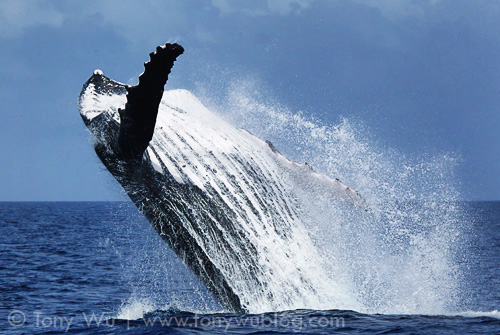
Breaching humpback whale, mother of calf #38
PS: We're up to 17 White Pecs now!
Humpback Whales in Tonga | Part 1
Humpback Whales in Tonga | Part 2
Humpback Whales in Tonga | Part 3
Humpback Whales in Tonga | Part 4